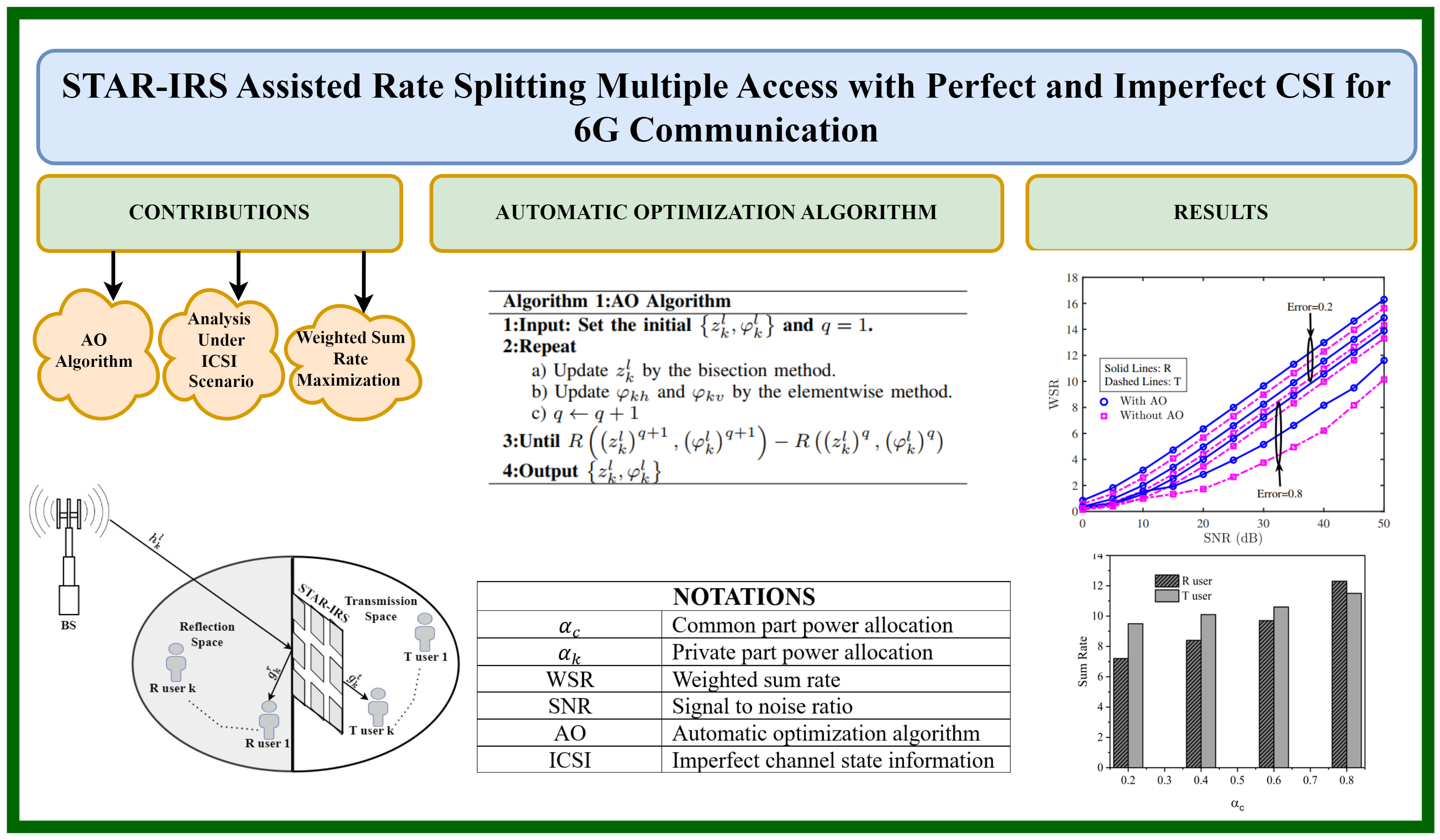STAR-IRS Assisted Rate Splitting Multiple Access with Perfect and Imperfect CSI for 6G Communication
Keywords:
STAR-IRS, RSMA, outage probability, weighted sum rate, optimization, and channel estimation errorAbstract
Incorporating cutting-edge technology like rate splitting multiple access (RSMA) and intelligent reflecting surface (IRS) are essential in 6G communications to satisfy the constantly growing needs for more connection, better reliability, and faster data rates. This paper explores the concept of simultaneously transmitting and reflecting IRS (STAR-IRS) assisted RSMA in the presence of both perfect and imperfect channel state information (CSI). STAR-IRS leverages its dual capability to transmit and reflect signals simultaneously, enhancing spectral efficiency and expanding coverage. So far, in literature, STARIRS assisted RSMA system is analyzed in terms of outage probability with perfect CSI scenario. So, in this work, we carry out the performance analysis of STAR-IRS in terms of outage probability and sum rate. Firstly, we derive the analytical expression of the outage probability and sum rate. Secondly, we propose a automatic optimization (AO) algorithm for weighted sum rate (WSR) maximization. The performance analysis is carried out by varying power allocation factor to find its optimality. The derived outage probability and sum rate expressions are validated with Monte Carlo simulations. Also, it is found that on using WSR maximization, the sum rate is enhanced for STAR-IRS based RSMA system when compared with the conventional sum rate maximization.
Downloads
References
C. Huang, A. Zappone, G. C. Alexandropoulos, M. Debbah and C. Yuen, "Reconfigurable Intelligent Surfaces for Energy Efficiency
in Wireless Communication," in IEEE Transactions on Wireless Communications, vol. 18, no. 8, pp. 4157-4170, Aug. 2019, doi: 10.1109/TWC.2019.2922609.
S. Hu, F. Rusek and O. Edfors, "Beyond Massive MIMO: The Potential of Data Transmission With Large Intelligent Surfaces," in IEEE Transactions on Signal Processing, vol. 66, no. 10, pp. 2746-2758, 15 May15, 2018, doi: 10.1109/TSP.2018.2816577.
M. Cui, G. Zhang and R. Zhang, "Secure Wireless Communication via Intelligent Reflecting Surface," in IEEE Wireless Communications Letters, vol. 8, no. 5, pp. 1410-1414, Oct. 2019, doi: 10.1109/LWC.2019.2919685.
Q. Wu and R. Zhang, "Towards Smart and Reconfigurable Environment: Intelligent Reflecting Surface Aided Wireless Network," in IEEE Communications Magazine, vol. 58, no. 1, pp. 106-112, January 2020, doi: 10.1109/MCOM.001.1900107.
L. Sanguinetti, E. Björnson and J. Hoydis, "Toward Massive MIMO 2.0: Understanding Spatial Correlation, Interference Suppression, and Pilot Contamination," in IEEE Transactions on Communications, vol. 68, no. 1, pp. 232-257, Jan. 2020, doi: 10.1109/TCOMM.2019.2945792.
H. Guo, Y. -C. Liang, J. Chen and E. G. Larsson, "Weighted SumRate Maximization for Intelligent Reflecting Surface Enhanced Wireless
Networks," 2019 IEEE Global Communications Conference (GLOBECOM), Waikoloa, HI, USA, 2019, pp. 1-6, doi: 10.1109/GLOBECOM38437.2019.9013288.
Yu, Xianghao, Dongfang Xu, and Robert Schober. "MISO wireless communication systems via intelligent reflecting surfaces." 2019 IEEE/CIC International Conference on Communications in China (ICCC). IEEE, 2019, doi:10.48550/arXiv.1904.12199.
J. Xu, Y. Liu, X. Mu and O. A. Dobre, "STAR-RISs: Simultaneous Transmitting and Reflecting Reconfigurable Intelligent Surfaces," in IEEE
Communications Letters, vol. 25, no. 9, pp. 3134-3138, Sept. 2021, doi: 10.1109/LCOMM.2021.3082214.
Xu, Jiaqi, et al. "STAR-RISs: Simultaneous transmitting and reflecting reconfigurable intelligent surfaces." IEEE Communications Letters 25.9 (2021), doi:10.48550/arXiv.2101.09663.
H. Niu, Z. Chu, F. Zhou, P. Xiao and N. Al-Dhahir, "Weighted Sum Rate Optimization for STAR-RIS-Assisted MIMO System," in IEEE
Transactions on Vehicular Technology, vol. 71, no. 2, pp. 2122-2127, Feb. 2022, doi: 10.1109/TVT.2021.3131568.
Zhao, Boqun, et al. "Ergodic rate analysis of STAR-RIS aided NOMA systems." IEEE Communications Letters 26.10 (2022), doi:10.48550/arXiv.2207.11304.
O. Dizdar, Y. Mao, W. Han and B. Clerckx, "Rate-Splitting Multiple Access: A New Frontier for the PHY Layer of 6G," 2020 IEEE 92nd
Vehicular Technology Conference (VTC2020-Fall), Victoria, BC, Canada, 2020, pp. 1-7, doi: 10.1109/VTC2020-Fall49728.2020.9348672.
Park, Jeonghun, et al. "Rate-splitting multiple access for 6G networks: Ten promising scenarios and applications." IEEE Network (2023), doi:10.48550/arXiv.2306.12978.
Dizdar, Onur, Yijie Mao, and Bruno Clerckx. "Rate-splitting multiple access to mitigate the curse of mobility in (massive) MIMO
networks." IEEE Transactions on Communications 69.10 (2021), doi:10.48550/arXiv.2102.06405
Mao, Yijie, Bruno Clerckx, and Victor OK Li. "Rate-splitting multiple access for downlink communication systems: Bridging, generalizing, and outperforming SDMA and NOMA." EURASIP journal on wireless communications and networking 2018 (2018), doi:10.1186/s13638-018- 1104-7.
J. Xu, L. Yuan, N. Yang, N. Yang and Y. Guo, "Performance Analysis of STAR-IRS Aided NOMA Short-Packet Communications With Statistical CSI," in IEEE Transactions on Vehicular Technology, vol. 72, no. 9, pp. 12385-12390, Sept. 2023, doi: 10.1109/TVT.2023.3266830.
Y. Mao, B. Clerckx and V. O. K. Li, "Rate-Splitting Multiple Access for Coordinated Multi-Point Joint Transmission," 2019 IEEE International Conference on Communications Workshops (ICC Workshops), Shanghai, China, 2019, pp. 1-6, doi: 10.1109/ICCW.2019.8756668.
H. Dahrouj and W. Yu, "Multicell Interference Mitigation with Joint Beamforming and Common Message Decoding," in IEEE Transactions on Communications, vol. 59, no. 8, pp. 2264-2273, August 2011, doi: 10.1109/TCOMM.2011.060911.100554.
S. Dhok and P. K. Sharma, "Rate-Splitting Multiple Access With STAR RIS Over Spatially-Correlated Channels," in IEEE Transactions
on Communications, vol. 70, no. 10, pp. 6410-6424, Oct. 2022, doi: 10.1109/TCOMM.2022.3198121.
Guo, Huayan, et al. "Weighted sum-rate maximization for reconfigurable
intelligent surface aided wireless networks." IEEE transactions on wireless communications 19.5 (2020), doi:10.48550/arXiv.1912.11999
S. Atapattu, C. Tellambura and H. Jiang, "A Mixture Gamma Distribution to Model the SNR of Wireless Channels," in IEEE Transactions
on Wireless Communications, vol. 10, no. 12, pp. 4193-4203, December 2011, doi: 10.1109/TWC.2011.111210.102115.
S. Al-Ahmadi and H. Yanikomeroglu, "On the approximation of the generalized-κ distribution by a gamma distribution for modeling composite fading channels," in IEEE Transactions on Wireless Communications, vol. 9, no. 2, pp. 706-713, February 2010, doi:
1109/TWC.2010.02.081266.
Zuo, Jiakuo, et al. "Joint design for simultaneously transmitting and reflecting (STAR) RIS assisted NOMA systems." IEEE Transactions on Wireless Communications 22.1 (2022), doi:10.48550/arXiv.2106.03001.
K. Shen and W. Yu, "Fractional Programming for Communication Systems—Part I: Power Control and Beamforming," in IEEE Transactions on Signal Processing, vol. 66, no. 10, pp. 2616-2630, 15 May15, 2018, doi: 10.1109/TSP.2018.2812733.


